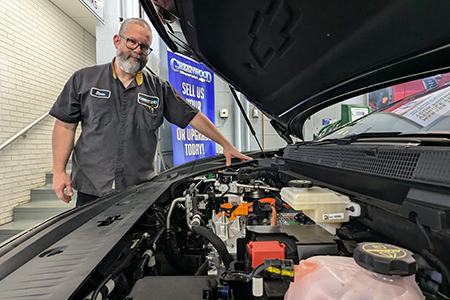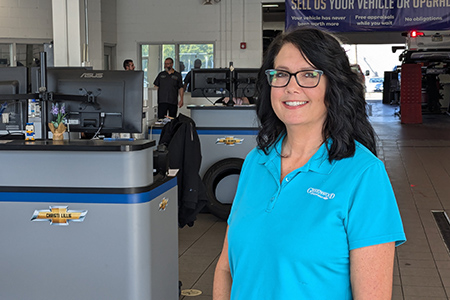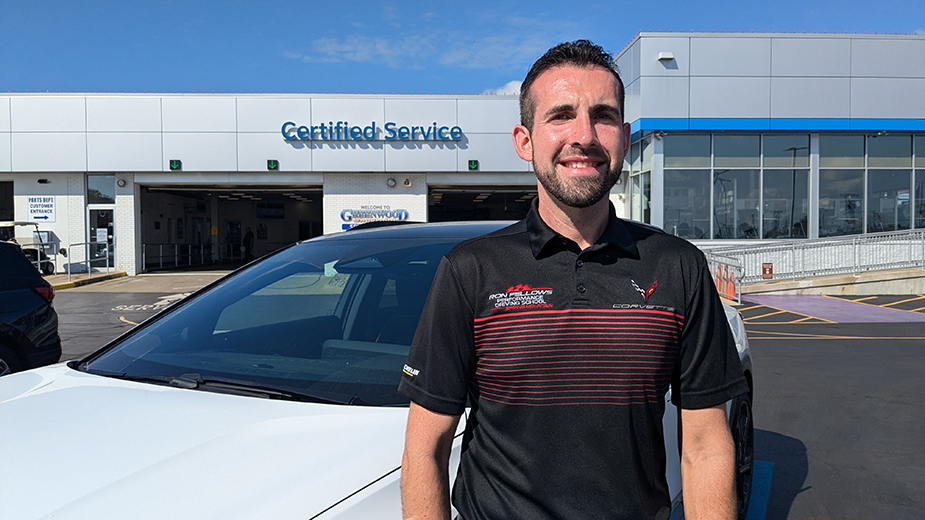AUSTINTOWN, Ohio – Steve Barto attributes his skills as an automotive technician and love of all things mechanical to his formative years.
“I grew up on a farm,” says Barto, a service technician at Greenwood Chevrolet in Austintown. “When things broke, you fixed it. You learn from doing and take it as it comes.”
This matter-of-fact philosophy has helped Barto earn credentials as a certified electric-vehicle technician, one of two employed at the dealership. While he perfected his skills working on traditional vehicles with internal combustion engines, he simultaneously embraced the emerging electrification market early on, as more hybrid models were introduced to consumers.
“I actually started training in 2006,” he recalls, preparing for the 2007 model year, when General Motors announced plans to develop a new slate of fuel-efficient hybrid vehicles that could run on a gasoline engine that also powered an electric motor. Among the first vehicles he worked on was an early hybrid version of the Chevrolet Tahoe SUV.
“Those were more of a hybrid, where the [internal combustion engine] went along with the electric motors,” Barto says. “Now, we’re transitioning to the stand-alone electric vehicle.”

Barto says that maintaining certification as an EV technician is an ongoing process, requiring perennial course work from a curriculum designed by GM. “As long as you’re staying up with all of your training and continuous education, you move forward from there,” he says. “It’s an ongoing process.”
The most glaring difference between training on a traditional engine and an EV is safety, Barto says. “You have to know what you’re doing – you have to follow the rules,” he says.
An EV’s motor architecture is entirely different from an internal combustion engine, Barto says as he pops the hood of a 2024 Equinox EV. At first glance, normal functional parts of a traditional automobile such as brake fluid and windshield washer fluid reservoirs are visible.
That’s where the similarity ends.
What’s striking is what isn’t under the hood. There are no noisy belt drives, no spark plugs, no radiator. An owner need not be concerned about oil changes, replacing a head gasket, or changing the transmission fluid. Repairing an exhaust system isn’t a concern either since there is no exhaust system in an EV.
Instead, a bright orange cable snakes through the center of the motor that connects with a central power module. The module is flanked on both sides with tubing and sophisticated electronics that governs just about everything in the vehicle.
NO FACTORY FLAWS
The heavy electrical content in these EVs requires additional safety precautions, Barto says. “You have to have 1,000-volt rated safety gloves, eye protection,” and other forms of personal protection. “You have to set up a perimeter, and once you’ve verified that the system has been powered down and safe, you can remove the equipment,” he says.
However, Barto has yet to deal with a customer experiencing major factory flaws in an EV. “I haven’t seen any major issues yet,” he says.
The maintenance work he’s performed on them was usually because of mishaps or neglect on the part of the owner. In one case, an owner left a vehicle – an early hybrid Malibu – sit for six months with its trunk open. Water had seeped in and flooded the vehicle, which inundated the battery in the back seat. In this instance, the water acted as a conductor and the battery couldn’t power down. “It’s the only time I’ve had a scenario where I worked from start to finish until I got the battery physically removed from the vehicle. The car had six inches of water in it – it’s a great scenario of extenuating circumstances.”
EV service technicians are trained in dozens of areas such as high voltage battery systems fundamentals, EV diagnosis and service, extended range EVs, and high voltage power electronics, according to GM. “Safety is the biggest thing,” he says. “There’s a whole curriculum.”

The automaker just recently rolled out a new course that is dedicated for first responders that Barto wants to review. “It’s just so they know how to disable one of these in case there’s an accident,” he says.
Barto says the Austintown dealership employs two technicians that are fully trained and certified for GM’s EV program. A third technician works at a second Greenwood dealership in Hubbard.
Christi Lillie, service adviser at Greenwood Chevrolet’s Austintown dealership, says that so far, there aren’t many EV owners coming to the dealership with problems. “I don’t get a lot of EV customers coming through here,” she says, aside from those seeking routine maintenance such as fluid and coolant changes, brake inspections, or tires. “So far, so good. They’re really dependable. I’m not seeing a continuous issue.”
SALES INCREASE
Service and support are integral to EV’s integration into the local market, says Jim Conlin, new car manager at Greenwood. Currently, the Austintown dealership has 16 EVs for sale on the lot. “We have enough inventory where we have added three units to our courtesy transportation program,” he says.
Despite slackening demand for EV pioneers such as Tesla, overall electric-vehicle sales across the United States increased 11.3% year-over-year during the second quarter, reaching a record-high volume of 330,463 vehicles, according to estimates from Kelley Blue Book. Analysts attribute this growth to attractive leasing programs, bigger discounts and increased options brought on by a host of new products introduced by automakers – especially GM.
While sales for EVs remain steady, GM has taken measures to introduce generous leasing programs for customers, Conlin says. These leasing rates vary and depend on the programs and how much money the customer is willing to put down, he says.
The new Equinox EV has emerged as the best-selling model at the dealership, Conlin says. “We have more than eight in stock, four more in transit, and another five more that are scheduled to be produced in the coming months.”
Also coming soon is the first ever all-wheel drive Corvette E-Ray, the first electrified Corvette. The new Corvette features a V8 engine that works in sync with front electric motors. The sticker price for this luxury model starts at approximately $104,900, he says, and is targeted to a select buying group.
CHARGING STATIONS
GM has also taken measures to allay fears among the buying public related to charging infrastructure across the country. In September, the automaker announced that all GM EV owners would be eligible for adapters that would accommodate Tesla’s charging network.
“GM customers now have access to the Tesla supercharger network,” he says. “That increases by 17,000-plus chargers that we can now use. So now, there’s a total of more than 231,000 charge points available nationwide for customers.”
Conlin says all of GM’s EVs come equipped with a Google-platform information system that identifies charging stations along a driver’s route to their destination. “When you put in a destination, it’ll automatically route and tell you where to stop, how long you’ll be there, and how much of a charge you’ll have when you reach your destination. It’s only going to grow from here,” he says.
Pictured at top: Jim Conlin, new car manager at Greenwood, says the Austintown dealership’s EV inventory is growing.
